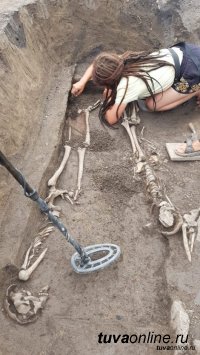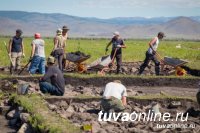 Archaeologists working in Tuva have discovered an undisturbed ancient kurgan—a tomb of a Scythian prince. The tomb appears to be both the oldest and largest of its kind ever recorded in southern Siberia, according to a press release from the Swiss National Science Foundation. Archaeologists working in Tuva have discovered an undisturbed ancient kurgan—a tomb of a Scythian prince. The tomb appears to be both the oldest and largest of its kind ever recorded in southern Siberia, according to a press release from the Swiss National Science Foundation.
Gino Caspari, an Swiss archaeologist with Bern University, first identified an intriguing circular structure while studying high-resolution satellite imagery of Siberia's Uyuk River Valley and suspected it could be a kurgan, according to the press release. A collaboration between Caspari and researchers from the Russian Academy of Sciences as well as the State Hermitage Museum carried out a preliminary dig over the summer of 2017; they found that Caspari had been right. A paper describing the research was published in the scientific journal Archaeological Research in Asia.
 The tomb, Tunnug 1, lies in a southern Siberian swamp that's part of the Russian republic of Tuva. Caspari told Newsweek that the tomb dates to a crucial period around 3,000 years ago, between the Bronze Age and the Iron Age, when "radical social changes" began to give rise to a nomadic culture. Little is known about this period, largely because very few archaeological remnants from it have yet been recovered. Tunnug 1, Caspari said, gives researchers a "huge chance" to learn more about this era of Eurasian prehistory. The tomb, Tunnug 1, lies in a southern Siberian swamp that's part of the Russian republic of Tuva. Caspari told Newsweek that the tomb dates to a crucial period around 3,000 years ago, between the Bronze Age and the Iron Age, when "radical social changes" began to give rise to a nomadic culture. Little is known about this period, largely because very few archaeological remnants from it have yet been recovered. Tunnug 1, Caspari said, gives researchers a "huge chance" to learn more about this era of Eurasian prehistory.
The fact that the tomb is in a swamp might account for the fact that it was discovered in a completely undisturbed condition; grave robbers would have to travel at least five hours by off-road vehicle to reach it, according to the press release. It's also a crucial find because the Uyuk River Valley features an underground layer of permafrost. In the summer, anything above it thaws and rots. But anything below it is preserved, quite literally frozen in time.
 "If it really turns out to be a permafrost tomb, we can hope for an exceptional preservation of objects that are usually not part of the archaeological record," Caspari told Newsweek via email. "Anything organic like wood carvings, felt items, clothing just to name a few. This would result in a much more vibrant look into the past than is usually possible." Other artifacts traditionally included in such tombs would be weapons, horse harnesses and various decorative objects. "If it really turns out to be a permafrost tomb, we can hope for an exceptional preservation of objects that are usually not part of the archaeological record," Caspari told Newsweek via email. "Anything organic like wood carvings, felt items, clothing just to name a few. This would result in a much more vibrant look into the past than is usually possible." Other artifacts traditionally included in such tombs would be weapons, horse harnesses and various decorative objects.
The ancient Scythians were a nomadic people who date back to the ninth century B.C. Caspari, who's made a documentary about his quest to find Scythian tombs using satellite data, said that this marked the very beginning of the research. Full excavations should begin in the spring, once the snow melts.
|
